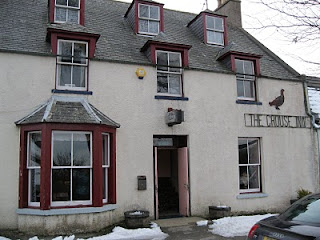
Take a step over the hill from Glass and follow the winding Deveron to discover a different world, not unlike Brigadoon that wakes up for one day in a hundred years then disappears again into the mists. The Cabrach, as the land is named is remote. The hills, covered in heather and broom, provide a home for red deer and rabbits --- as populous as in “Watership Down.” Like other Highland regions, the Cabrach was densely forested and home to wolves. They kept the deer and rabbit population in check and maintained the vitality of the forest.
Eking out a living on the land is hard as the heavy snowfalls are legendary; the growing season a month shorter than at Cottarton. The ground is less fertile.

You pass a single pay phone, a school and a post office then to reach a way station. Surrounded by a small cluster of houses The Grouse Inn is incongruous for its size and vitality. It’s the only country inn for miles around. How on earth does it survive in that sleepy community? Entering the bar you realize just how special the Inn is. They have at least 700 whiskies, most of which you can sample. An institution over two hundred years old, it's been operated by Ian and Wilma McBain since 1939, before that by the Watt family, before that the Stewarts. And so Amber, Adam and I sat down and tasted a rich, peaty malt, while Wilma told us about the land. The longer version is here. I was particularly interested in the chapel at Shenval, apparently the first Catholic chapel built since the Reformation. Because the Cabrach was so remote, and so cold (the Scottish Siberia), Catholics felt safe practicing there. The chapel apparently has an escape tunnel, for use by the priest in case the authorities came to arrest him.

Wilma has four rooms to rent, including one that’s haunted by various ghosts. Her tea room is well frequented. The Inn was and still is the social centre of the Cabrach. Once popular with fishermen catching salmon and trout in the Deveron and Blackwater, these days it survives thanks to busloads of summer tourists that stop by for afternoon tea and to sample the whisky. Amber and went to a Hogmany Party there and met many of our present friends.

I’d already noticed many empty houses that dot the landscape; standing shells with flocks of crows circling above. They tell their own story, that this was once a vital land of crofts and farms but for the past two hundred years has been losing population. The Cabrach School is still open for primary grades. Last year it had two students, hardly enough to keep going, yet the school clings on. Most of the land is owned by absentee landlords, interested more in preserving the land for grouse hunting than in renting or maintaining property. It's a trend that began two centuries ago with the Highland Clearances. There were cases only a few years back of empty houses being burned so that they’d be rendered uninhabitable.
In September 2007 the residents took matters into their own hands. They met at the Grouse and formed the Cabrach Community Association,
with the goal of returning land to local ownership and halting the depopulation. It’s a fledgling movement, but it shows how people can come together to preserve their community and their heritage. We wish them success.


